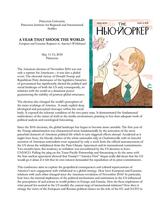
Oushakine, Serguei Alex. “CFP: An Interdisciplinary Conference: ‘A Year That Shook the World: European and Eurasian Responses to America’s Withdrawal’.” (May 11-13, 2018, Princeton) 2018: n. pag. Print.
Abstract
This conference aims to explore the geopolitical consequences and cultural repercussions of America's new engagement with withdrawal as a global strategy. How have European and Eurasian relations with each other changed since the American revolution of November 2016? In particular, how have the internal implosions of the political mechanisms and institutions in the US influenced the perceptions of and actions in world politics in Europe and Eurasia. How do these implosions of what passed for normal in the US modify the current map of international relations? How does it change the views of the European and Russian political classes on the role of the EU and NATO in the near future? What are the alternative political configurations and arrangements that are being envisioned and discussed in Europe and Eurasia against the backdrop of Trump’s America? Given the downward spiral of US-Russia relations, how is Russia’s presence in European relations understood and conceptualized by European and Eurasian elites and publics? Similarly, what are the roles that Europe is expected to play in Russia’s politics after the election of Donald Trump? In general, how does globalization look from the point of view of local actors in, say, Berlin, Rome, Tbilisi or Bishkek now, after the ostensible US disengagement from international institutions and networks?
We invite proposals from scholars of politics, social relations, history, culture, law, and media interested in analyzing changes of the political imaginaries in Europe and Eurasia after November 2016. We seek empirically grounded and theoretically informed accounts of cultural shifts, political and social transformations, as well as new conceptual frames that are emerging in “old” and “new” Europe, Russia, and Central Asia in response to the geopolitical challenges posed by the Trump administration.
We invite proposals from scholars of politics, social relations, history, culture, law, and media interested in analyzing changes of the political imaginaries in Europe and Eurasia after November 2016. We seek empirically grounded and theoretically informed accounts of cultural shifts, political and social transformations, as well as new conceptual frames that are emerging in “old” and “new” Europe, Russia, and Central Asia in response to the geopolitical challenges posed by the Trump administration.
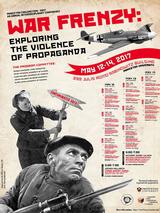
Oushakine, Serguei Alex. “An Interdisciplinary Conference ‘War Frenzy: Exploring the Violence of Propaganda’.” (May 12-14, 2017, Princeton) 2017: n. pag. Print.
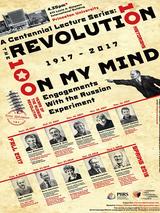
Oushakine, Serguei Alex. “The Revolution on My Mind: 1917-2017. A Centennial Lecture Series at Princeton University.” (September, 2017 - April, 2018, Princeton) 2017.
Abstract
The Russian Revolution occurred 100 years ago this year, and it dramatically influenced the course of the century that followed. Working on the Revolution over the course of a career has also changed the assumptions, convictions and careers of the historians who have tried to understand it.
The Centennial Lecture Series at Princeton University will feature ten prominent historians of the Revolution whose work has provided most of what we now know about that event. In this series, I have asked these scholars to reflect on the Revolution and the way it has changed the way that they think about writing history.
Borrowing its title from Jochen Hellbeck’s pioneering study of the transformative power of the revolutionary process, the series explores complicated networks of relations between history, power, and the self.
The Centennial Lecture Series at Princeton University will feature ten prominent historians of the Revolution whose work has provided most of what we now know about that event. In this series, I have asked these scholars to reflect on the Revolution and the way it has changed the way that they think about writing history.
Borrowing its title from Jochen Hellbeck’s pioneering study of the transformative power of the revolutionary process, the series explores complicated networks of relations between history, power, and the self.
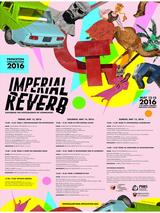
Oushakine, Serguei Alex. “‘IMPERIAL REVERB: Exploring The Postcolonies of Communism.’ Princeton Conjunction – 2016.” (May 13-15, 2016, Princeton) 2016: n. pag. Print.
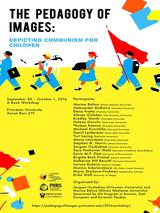
Oushakine, Serguei Alex. “A Book Workshop: The Pedagogy of Images: Depicting Communism for Children.” (Sept 30 - Oct 1, 2016, Princeton) 2016.
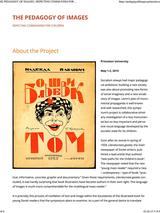
“The Pedagogy of Images: Depicting Communism for Children.” “.” (May 1-2, 2015, Princeton University) 2015: n. pag. Print.
Abstract
Soon after its revival in spring of 1929, Literaturnaia gazeta, the main newspaper of Soviet writers, published a lead article that outlined “new paths for the children’s book”. The newspaper noted that the new “young mass reader” required a new – contemporary – type of book: “practical, informative, concrete, graphic and documentary.” Given these requirements, Literaturnaia gazeta concluded, it was hardly surprising that book illustrators have become authors in their own right: “the language of images is much more comprehensible for the multilingual mass reader.”
It is precisely this process of conflation of text and image within the boundaries of the illustrated book for young Soviet readers that the symposium plans to examine. As a part of the general desire to translate Communism into idioms and images accessible to the illiterate, alternatively literate, and pre-literate, children’s books visualized ideological norms and goals in a way that guaranteed easy legibility and direct appeal, without sacrificing the political identity of the message. Relying on a process of dual-media rendering, illustrated books presented the propagandistic content as a simple narrative or verse, while also casting it in images. A vehicle of ideology, an object of affection, and a product of labor, the illustrated book for the young Soviet reader became an important cultural phenomenon, despite its perceived simplicity and often minimalist techniques. Major Soviet artists and writers contributed to this genre, creating a unique assemblage of sophisticated visual formats for the propaedeutics of state socialism.
It is precisely this process of conflation of text and image within the boundaries of the illustrated book for young Soviet readers that the symposium plans to examine. As a part of the general desire to translate Communism into idioms and images accessible to the illiterate, alternatively literate, and pre-literate, children’s books visualized ideological norms and goals in a way that guaranteed easy legibility and direct appeal, without sacrificing the political identity of the message. Relying on a process of dual-media rendering, illustrated books presented the propagandistic content as a simple narrative or verse, while also casting it in images. A vehicle of ideology, an object of affection, and a product of labor, the illustrated book for the young Soviet reader became an important cultural phenomenon, despite its perceived simplicity and often minimalist techniques. Major Soviet artists and writers contributed to this genre, creating a unique assemblage of sophisticated visual formats for the propaedeutics of state socialism.
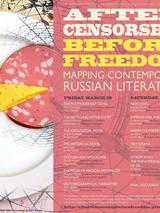
Oushakine, Serguei Alex. “After Censorship, Before Freedom: Mapping Contemporary Russian Literature..” (March 28-29, 2014, Workshop at Princeton University) 2014: n. pag. Print.
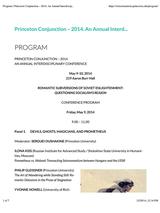
Oushakine, Serguei Alex. “Romantic Subversions of Soviet Enlightenment: Questioning Socialism’s Realism.” (May 9-10, 2014, Princeton University) 2014: n. pag. Print.
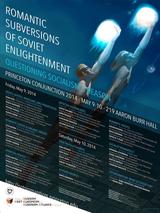
Oushakine, Serguei Alex. “Romantic Subversions of Soviet Enlightenment: Questioning Socialism’s Realism.” (May 9-10, 2014, Princeton University) 2014: n. pag. Print.
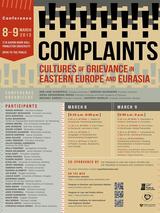
Oushakine, Serguei Alex. “COMPLAINTS: Cultures of Grievance in Eastern Europe and Eurasia.” (March 8-9, 2013, Princeton University) 2013: n. pag. Print.
Abstract
The conference Complaints: Cultures of Grievance in Eastern Europe and Eurasia builds on a diverse scholarship on public criticism and dissatisfaction by bringing together an international and interdisciplinary group of researchers from a range of disciplines including law, history, anthropology, sociology, politics, philosophy, psychology, art and literary criticism. The conference will trace the emergence and development of cultures of grievances – those ritualized discourses in which responses to the authorities are merged with their interrogation.
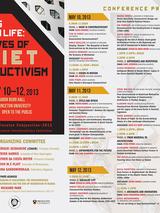
Oushakine, Serguei Alex. “‘Illusions Killed by Life’: Afterlives of (Soviet) Constructivism.” (May 10-12, 2013, Princeton ) 2013: n. pag. Print.
Abstract
The conference explored the remains, revenants and legacies of Soviet Constructivism through the 1940-1970s – both in the USSR and beyond. We are interested in historically grounded and theoretically informed papers that map out the post-utopian and disenchanted period of “the Constructivist method.” No longer “a Communist expression of material constructions” (to use Gan’s formulation), these belated Constructivisms made themselves known mostly indirectly: for example, in the heated debates about the role and importance of aesthetics under socialism, in the functionalist idiom of mass housing, in the visual organization of museum space, or in the reception and development of constructivist concepts in architectural deconstruction.
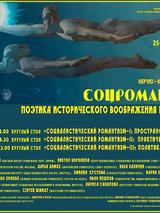
Oushakine, Serguei Alex. “Соцромантизм: поэтика исторического воображения в позднем СССР (Иркутск, 25-26 августа 2013 г.).” (Иркутск, 25-26 августа 2013 г.) 2013: n. pag. Print.
Abstract
Мы предлагаем начать новый виток обсуждения поздне-советской истории, сознательно оставляя в стороне как классические и ревизионистские версии социализма, так и сложившиеся подходы к анализу (и критике) соцреализма. Вместо этого, свою аналитическую ревизию недавнего советского прошлого (1961-1991), мы хотим построить на основе теоретического и концептуального багажа, накопленного в исследованиях классического европейского романтизма. Отталкиваясь от историографических исследований Хейдена Уайта («Метаистория: Историческое воображение в Европе XIX века»), мы предлагаем видеть в позднесоветской культуре специфическую форму исторического сознания, ярче всего проявившего себя в романтических моделях интерпретации и концептуализации истории. Мы имеем в виду не только акцент на аффективных аспектах социальных отношений (та самая «сложная искренность», о которой писал В. Померанцев в 1953 году), но и специфически советское понимание общества и места индивида в этом обществе. Понимание, тесным образом связанное с идеей развития и подвижности, как в личностном, так и пространственном смысле. В рамках такого подхода поздне-советское время приобретает классические романтические черты «драмы освобождения духовной силы», «драмы самоидентификации» (о которой пишет Уайт), с ее постоянным конфликтом между импульсом к освобождению/саморазвитию и силами, встающими на пути этого развития.
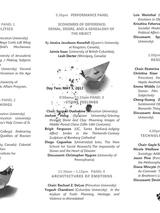
Oushakine, Serguei Alex. “Objects of Affection: Towards Materiology of Emotions.” (May 4-6, 2012, Princeton) 2012: n. pag. Print.
Abstract
Taking the Russian avant-garde’s concern with the material life of emotions as our starting point, the conference brings together an international, interdisciplinary group of scholars working at the intersection between studies of affect and studies of material culture. In the last decade, these two crucial strands of social inquiry have shifted the focus of analytic attention away from the individual or collective subject towards emotional states and material substances. These interests in the affective and the tangible as such have helped to foreground processes, conditions, and phenomena that are relatively autonomous from the individuals or social groups that originally produced them.
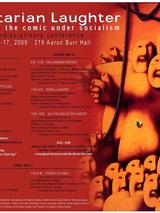
Oushakine, Serguei Alex. “Totalitarian Laughter: Cultures of the Comic under Socialism.” (May 8-9, 2009, Princeton) 2009: n. pag. Print.
Abstract
Throughout its history, socialist mass culture actively relied on satire, humor, and comedy to foster emotional bonds with its audience. Orchestrated by the state cultural industry, public laughter released social and political tension, while leaving intact or buttressing mechanisms of repression and institutions of power. In turn, late Soviet irony or the aesthetic of grotesque, developed from below, became instrumental in solidifying a cultural distance from the values promoted by the socialist state. Varied in their impact and scope, these cultures of the comic nonetheless constantly pointed to the irrationality and ludicrousness of the socialist way of life.
Whether officially approved or censored, totalitarian laughter relativized existing practices and norms, suggesting different models of understanding and embodying really existing socialism. Regardless of their content, these jokes of repression shared the same quality: they were made, not found. It is precisely this active production of totalitarian laughter from above and from below that this conference aims to explore. How did state socialism transform traditional genres and categories of the comic? How crucial was state censorship in producing (or suppressing) totalitarian laughter? Through what forms of displacement and condensation did official and non-official cultures achieve their comic effect? How did these practices of the comic correspond and interact with each other? What kinds of communities were formed in the process of producing jokes of repression? What were the mechanisms and paths of circulation through which laughable versions of socialism became available to larger audiences? Finally, what kinds of pleasure did totalitarian laughter promise, if not deliver?
Whether officially approved or censored, totalitarian laughter relativized existing practices and norms, suggesting different models of understanding and embodying really existing socialism. Regardless of their content, these jokes of repression shared the same quality: they were made, not found. It is precisely this active production of totalitarian laughter from above and from below that this conference aims to explore. How did state socialism transform traditional genres and categories of the comic? How crucial was state censorship in producing (or suppressing) totalitarian laughter? Through what forms of displacement and condensation did official and non-official cultures achieve their comic effect? How did these practices of the comic correspond and interact with each other? What kinds of communities were formed in the process of producing jokes of repression? What were the mechanisms and paths of circulation through which laughable versions of socialism became available to larger audiences? Finally, what kinds of pleasure did totalitarian laughter promise, if not deliver?
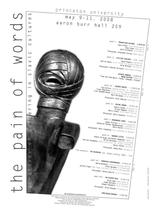
Oushakine, Serguei Alex. “The Pain of Words: Narratives of Suffering in Slavic Cultures.” (May 9-11, 2008, Princeton) 2008: n. pag. Print.
Abstract
Recent studies of emotions have pointed to a particular role of pain in shaping identities and narratives. Regardless of their
disciplinary affiliations, scholars seem to agree that verbal
expressions of pain first of all draw attention to the suffering
individual instead of describing the actual experience of pain.
Narratives of suffering provide the individual with a powerful
symbolic presence. They create emotionally charged communities. Such narratives also lay the foundation for larger social, political or moral claims.
This link between pain, representation, and subjectivity is well
documented in Slavic cultures, where vivid depictions of suffering saturate popular and elite cultures alike. As the young Mayakovski put it, "I am with pain, everywhere." However, this conference wants to move beyond the documenting of omnipresence of pain in Slavic cultures. Instead, we want to explore how social, linguistic, aesthetic, moral, gender, etc. conventions determine specific contents of pain in different historical periods and different geographical locations. What are the symbolic contexts in which experiences of pain are recognized? To what extent do available cultural practices constrain or encourage certain narrative versions of pain? What gets lost in the process of translating traumatic experience into narratives of suffering? How is the phenomenon of pain used to galvanize individual and group identities, to justify social values, to motivate artistic projects or, in some cases, to undermine(or generate) political movements? In short, what are those discourses through which Slavic cultures acquire and express their concepts of pain?
disciplinary affiliations, scholars seem to agree that verbal
expressions of pain first of all draw attention to the suffering
individual instead of describing the actual experience of pain.
Narratives of suffering provide the individual with a powerful
symbolic presence. They create emotionally charged communities. Such narratives also lay the foundation for larger social, political or moral claims.
This link between pain, representation, and subjectivity is well
documented in Slavic cultures, where vivid depictions of suffering saturate popular and elite cultures alike. As the young Mayakovski put it, "I am with pain, everywhere." However, this conference wants to move beyond the documenting of omnipresence of pain in Slavic cultures. Instead, we want to explore how social, linguistic, aesthetic, moral, gender, etc. conventions determine specific contents of pain in different historical periods and different geographical locations. What are the symbolic contexts in which experiences of pain are recognized? To what extent do available cultural practices constrain or encourage certain narrative versions of pain? What gets lost in the process of translating traumatic experience into narratives of suffering? How is the phenomenon of pain used to galvanize individual and group identities, to justify social values, to motivate artistic projects or, in some cases, to undermine(or generate) political movements? In short, what are those discourses through which Slavic cultures acquire and express their concepts of pain?
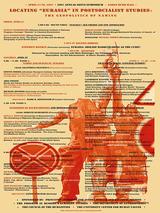
Oushakine, Serguei Alex. “Locating ‘Eurasia’ in Postsocialist Studies: The Geopolitics of Naming.” (April 27-29, 2007, Princeton) 2007: n. pag. Print.

